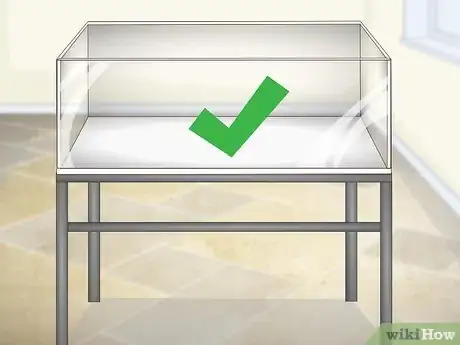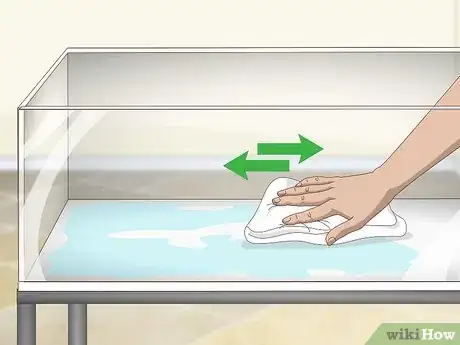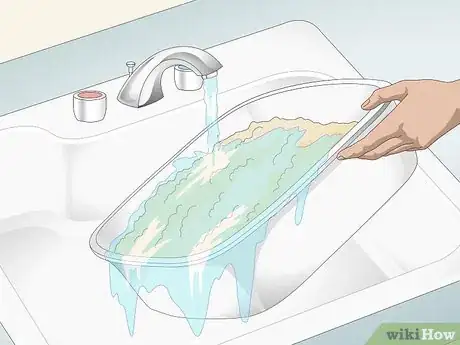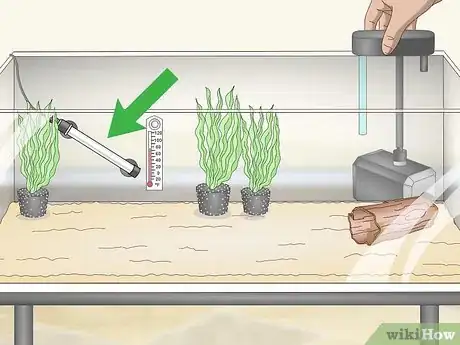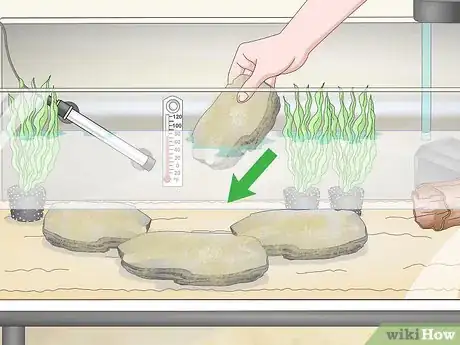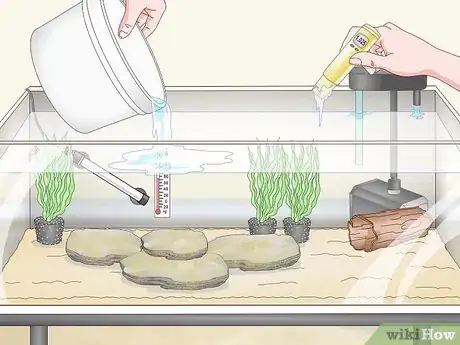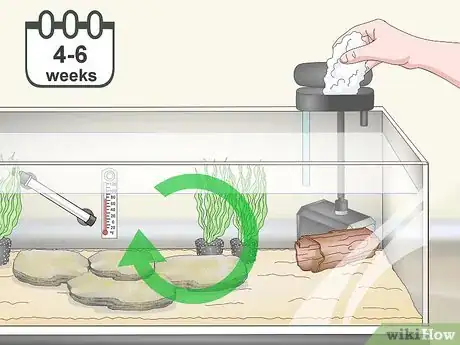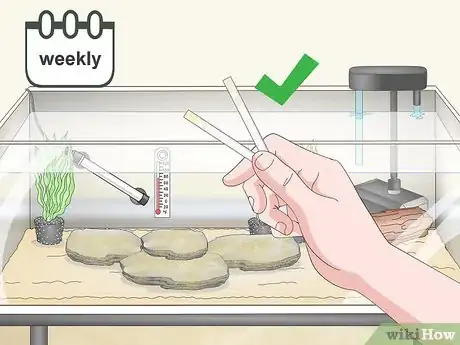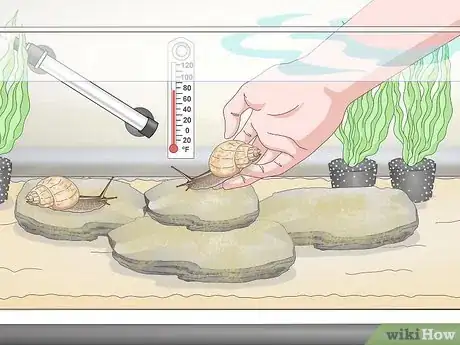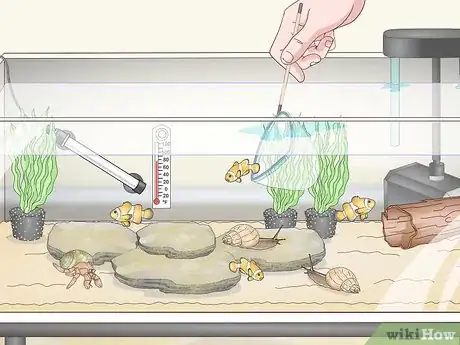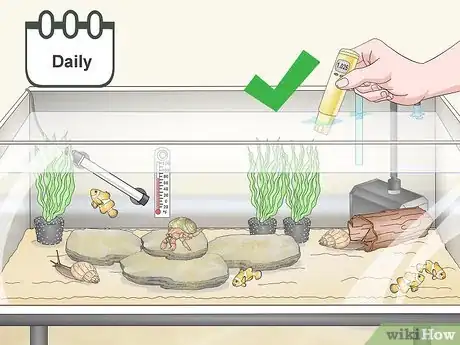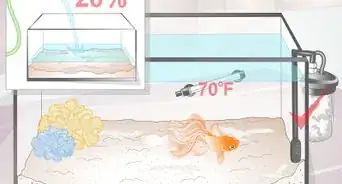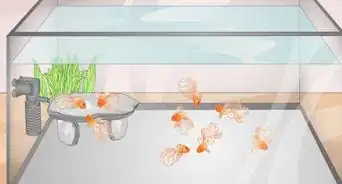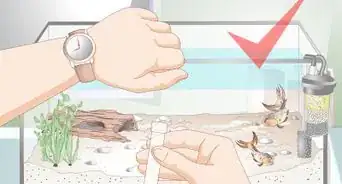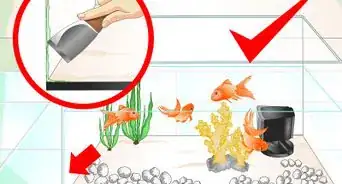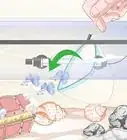This article was co-authored by Doug Ludemann. Doug Ludemann is the owner and operator of Fish Geeks, LLC, an aquarium services company based in Minneapolis, Minnesota. Doug has worked in the aquarium and fish-care industry for over 20 years, including having worked as a professional aquarist for the Minnesota Zoo and Shedd Aquarium in Chicago. He received his Bachelor of Science in Ecology, Evolution, and Behavior from the University of Minnesota.
wikiHow marks an article as reader-approved once it receives enough positive feedback. In this case, 100% of readers who voted found the article helpful, earning it our reader-approved status.
This article has been viewed 859,570 times.
Marine reef aquariums, or saltwater aquariums, host beautiful coral, fish, and other colorful creatures, and they’re a great addition to many homes and offices. It can take several months to properly set up your aquarium, but with a little patience and research, you can create a thriving habitat that you’ll enjoy for years and years.
Steps
Setting up the Tank
-
1Pick out a tank and tank stand that fits your space and budget. As a beginner, you may be tempted to get a small tank, but it’s actually hard on your fish to transition from a small tank to a large one over time. For the best results, pick the largest one you can that fits into your budget and allocated space (choose a location that’s away from doors, windows, and heating units). A 48 in (120 cm), 120 US gal (450 L) tank is a great choice for beginners. Buy a tank stand rather than relying on a piece of furniture you already have.[1]
- A 10 US gal (38 L) tank could easily weigh over 1,000 pounds (450 kg) once it’s full of water, creatures, and rocks. Aquarium stands are specifically built to hold that volume, whereas your normal table or TV stand isn’t meant to withhold that much weight.
- Most tank stands are designed to also house the tank’s equipment, so it provides storage as well as a base for the tank.
-
2Wipe down the tank with a clean, damp cloth. Take a clean, damp washcloth or rag and thoroughly wipe out the interior of the tank, the top rim, and the outside of the tank. Rinse the tank out with lukewarm water and let it air dry.[2]
- Never use bleach, detergent, soaps, or any other kind of abrasive cleaner on the tank.
Advertisement -
3Rinse off any gravel or substrate before adding it to the tank. You don’t have to use gravel, but if you choose to, rinse it out in a colander before putting it in the tank. Use 1 pound (0.45 kg) of gravel or substrate for each gallon in your aquarium to create a 1 inch (2.5 cm) thick bed of gravel. After the gravel is rinsed, spread it out evenly over the bottom of the tank.[3]
- Substrate is sandy, and it’s a better material for fish that like to burrow. If you’re planning on buying fish that burrow, get substrate. Otherwise, gravel should be just fine!
- Rinsing the gravel beforehand will get rid of excess dust, which will put less strain on the filtration system.
- Adding or not adding gravel is a personal preference. Some people prefer the way an ungraveled tank looks.
-
4Hook up the equipment before adding water to the tank. Make sure to read all the instructions that come along with the equipment as you set up each piece. Luckily, many pieces of equipment are built to work with various sizes of tanks, so you should have lots of options available to you when you start researching; just make sure the equipment specifies it is meant for saltwater aquariums. For a basic tank, you will need:[4]
- A protein skimmer or filter[5]
- A heater and thermometer
- A circulation pump
- Aquarium lighting
- You can, of course, buy new equipment from aquarium stores. You could also look to purchase equipment from other people in the aquarium community. If you do that, just look for a reputable seller and check that the equipment works properly before you pay for it.
-
5Fill the tank halfway with saltwater and test the salinity.[6] Never use table salt in your aquarium. Purchase pre-mixed saltwater from the aquarium store, or make your own by mixing reverse-osmosis water and a sea salt mix, which can be bought from the aquarium store. Follow the instructions on the sea salt mix to combine the right proportions for your tank. Keep adding salt or water until the hydrometer reads 1.025.
- Don’t use distilled water. Distillation generally filters through copper piping, and copper can kill coral and other fishes.
- You’re only filling the tank halfway so that you will have space to aquascape the tank without causing water to spill over the top.
-
6Run the filtration system for 24 hours. Before adding live rock or any creatures of any kind, turn on the filtration system and let it run for at least 24 hours. Check that the equipment runs properly, and troubleshoot any hardware issues you come across.[7]
- Letting the filter run for 24 hours helps purify the water and clean out any dust that is present in the tank. Part of running a successful aquarium is taking the time to let the water and tank acclimate correctly.
Adding Live Rock and Cycling the Tank
-
1Add live rock to the tank so it takes up about 1/3 of the space. Purchase live rock from the aquarium supply store. Don’t set the rock against the back wall of the aquarium; rather, try and spread the live rock out across the entire tank to create multiple enclaves and overhangs. If there are other decorative pieces you want to add to your tank, now is the time to do so.
- Take your time placing the live rock in your tank and try out different arrangements to see which you like best. Before you add any living creatures to the tank is the best time to move the live rock around.
- Don’t turn on the aquarium lights just yet. You can leave them off until you add the first fish or invertebrates to the tank.
- Look for live rock that has been “cured.” This means that toxic compounds have already been removed from the rock.[8]
-
2Fill the tank the rest of the way with saltwater and test it again. Depending on how much live rock you added to the tank, there may still be a gap of space between the water and the top of the lid. If so, add more saltwater until it reaches the top of the tank. Test the salinity of the water and make adjustments until it returns to the 1.025 level.
- At this stage, it’s okay if the salt level is a little off. The tank has to cycle for several weeks before you add your first fish, so there is time to make any adjustments that need to be done.
-
3Cycle the water and clean the filter for 4 to 6 weeks. During this time, clean out the filter daily—once it is no longer dirty on a daily basis, you can slow the filter cleaning to every other day or twice a week. You can also do a water change on a weekly basis, which is where you will remove 1/2 of the water from the tank and replace it with fresh saltwater.[9]
- Don’t add any fish or other creatures to the tank during this cycling phase.
-
4Check the ammonia and nitrate levels every week until they reach 0. Most experts recommend purchasing a test kit to measure these levels. It can take anywhere from 4 to 6 weeks for the nitrate and ammonia in the water to start reacting and reach the appropriate level. Once the levels reach 0, you can move on to the process of adding live creatures to your tank.[10]
- Too much ammonia can kill off living creatures within hours.
- Nitrogen is what helps convert ammonia into a compound that won’t harm the fish.
- Ammonia should be undetectable by a testing kit. If it is registering, chances are the tank needs to cycle more, or perhaps the filter is clogged.
- Consider adding bio pellets to your tank to help keep your tank balanced. Bio pellets are a carbon source that nourishes the bacteria in your tank. That bacteria naturally consumes the phosphorous and nitrogen in the water, so they can help keep the levels where they need to be. However, if you're using GFO in your tank, you can get the phosphate down to a point where the bacteria can't thrive, so they basically cancel each other out.[11]
Introducing Live Fish and Creatures to the Tank
-
1Put algae-eating creatures into the tank first. Scavengers, like snails and hermit crabs, are the best creatures to add to your tank before adding anything else. They are very hardy and will do some extra cleaning work for you. Add 1 algae eater for every 10 gallons (38 L) of water in your tank.
- Check out the nassarius snail, tailspot blenny, trochus snail, kole tang, and emerald crab, or ask the experts at your local aquatics store for a recommendation.
-
2Wait at least 2 weeks between each new addition to your tank. After adding the algae eaters, let the tank cycle for at least 2 weeks before adding anything else. Continue testing the ammonia and nitrate levels, and clean out the filter on a weekly basis.
- This gives the creatures and the tank time to adjust and filter properly. If you were to add all the fish you want at once, they may go into shock, or the tank may not be able to adjust quickly enough to support them.
-
3Add healthy fish and invertebrates to the tank over time. Put 2 to 3 new specimens into your tank every 2 weeks until your tank is as full as you’d like it to be. This gives the biological filtration system time to adjust between each new addition and makes it more likely that your fish will stay healthy.[12]
- If a tank already has dead or dying fish in it, do not purchase a fish from it.
- Research each fish before adding them to your tank.[13]
-
4Check the water level, temperature, and equipment on a daily basis.[14] The best way to keep your tank running efficiently and your fish happy and healthy is to perform a cursory check of the entire tank every day. This doesn’t have to be time-consuming—add water if the level is low, clean out a filter if it’s full, and make sure your fish look healthy. You can also check the ammonia and nitrate levels on a weekly basis to make sure they’re appropriate.[15]
- Make your aquarium check part of your daily routine so you don’t forget about it.
Expert Q&A
Did you know you can get expert answers for this article?
Unlock expert answers by supporting wikiHow
-
QuestionHow can I prevent excess algae growth in my marine reef aquarium?
 Doug LudemannDoug Ludemann is the owner and operator of Fish Geeks, LLC, an aquarium services company based in Minneapolis, Minnesota. Doug has worked in the aquarium and fish-care industry for over 20 years, including having worked as a professional aquarist for the Minnesota Zoo and Shedd Aquarium in Chicago. He received his Bachelor of Science in Ecology, Evolution, and Behavior from the University of Minnesota.
Doug LudemannDoug Ludemann is the owner and operator of Fish Geeks, LLC, an aquarium services company based in Minneapolis, Minnesota. Doug has worked in the aquarium and fish-care industry for over 20 years, including having worked as a professional aquarist for the Minnesota Zoo and Shedd Aquarium in Chicago. He received his Bachelor of Science in Ecology, Evolution, and Behavior from the University of Minnesota.
Professional Aquarist
-
QuestionI was given a supermarket lobster tank. Can I turn it into a fresh water tank?
 Community AnswerIt entirely depends on how big the tank is and what you plan to put in it. Generally, any tank can be a freshwater tank if it's big enough for the livestock you choose to put in it.
Community AnswerIt entirely depends on how big the tank is and what you plan to put in it. Generally, any tank can be a freshwater tank if it's big enough for the livestock you choose to put in it. -
QuestionI am starting up a 240 gallon saltwater aquarium. It sat in a garage for approximately four years under a cover and only moved twice. I leak-checked it and all is fine. Do I need to redo the seams?
 Community AnswerYou shouldn´t have to redo them, but it might be beneficial to touch them up.
Community AnswerYou shouldn´t have to redo them, but it might be beneficial to touch them up.
Things You’ll Need
- Aquarium
- Aquarium stand
- Washcloth
- Gravel or substrate (optional)
- Colander
- Nitrate and ammonia test kits
- Hydrometer
- Live rock
- Aquarium lights
- Algae-eating creatures
- Fish and invertebrates
- Protein skimmer or filter
- Heater
- Thermometer
- Circulation pump
References
- ↑ https://youtu.be/q0WwT4j86a0?t=40
- ↑ https://www.earthsfriends.com/saltwater-aquarium-for-beginners/
- ↑ https://www.earthsfriends.com/saltwater-aquarium-for-beginners/
- ↑ https://youtu.be/q0WwT4j86a0?t=370
- ↑ Doug Ludemann. Aquarium Care Professional. Expert Interview. 27 August 2019.
- ↑ Doug Ludemann. Aquarium Care Professional. Expert Interview. 27 August 2019.
- ↑ https://www.earthsfriends.com/saltwater-aquarium-for-beginners/
- ↑ https://www.earthsfriends.com/saltwater-aquarium-for-beginners/
- ↑ https://www.earthsfriends.com/saltwater-aquarium-for-beginners/
- ↑ https://users.cs.duke.edu/~narten/faq/cycling.html
- ↑ Doug Ludemann. Aquarium Care Professional. Expert Interview. 27 August 2019.
- ↑ https://www.earthsfriends.com/saltwater-aquarium-for-beginners/
- ↑ Doug Ludemann. Aquarium Care Professional. Expert Interview. 27 August 2019.
- ↑ Doug Ludemann. Aquarium Care Professional. Expert Interview. 27 August 2019.
- ↑ https://www.earthsfriends.com/saltwater-aquarium-for-beginners/
- ↑ https://www.earthsfriends.com/saltwater-aquarium-for-beginners/
About This Article
To set up a marine reef aquarium, start by getting a large glass tank and lining the bottom of it with a substrate, like sand or gravel. Then, install a filter, heater, and pump in your tank so you can maintain the proper water conditions for your fish and reef. Next, fill the tank halfway with saltwater, and run the filtration system for 24 hours to purify the water. Finally, place some live rock in the tank, and fill it up the rest of the way with saltwater before cycling it for 4-6 weeks. To learn how to introduce fish to your marine reef aquarium, scroll down!
